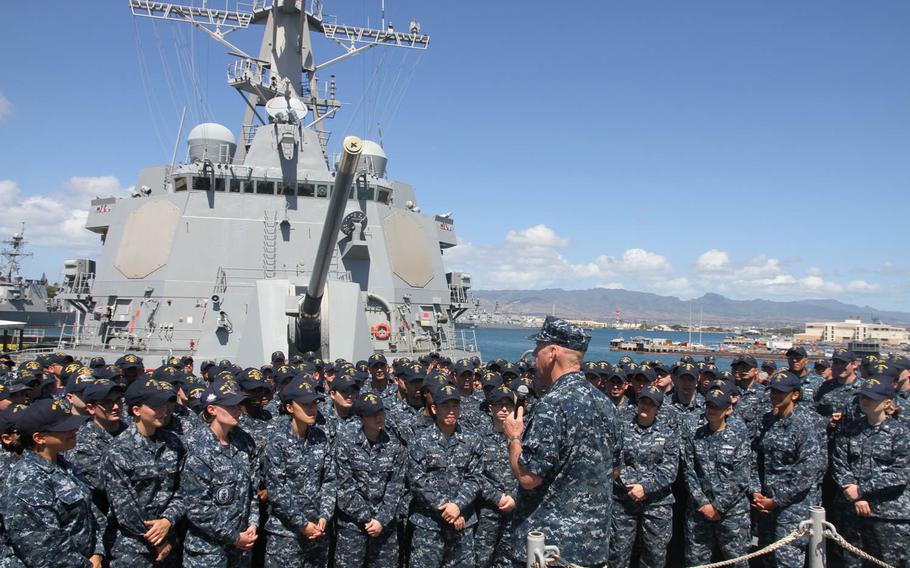
Adm. Scott Swift, U.S. Pacific Fleet commander, speaks to sailors during an all-hands call aboard the USS Momsen Tuesday, April 26, 2016, at Joint Base Pearl Harbor-Hickam, Hawaii. The Momsen and two other Arleigh Burke-class destroyers arrived a week ago from the West Coast and will deploy for seven months as a surface-action group under the 3rd Fleet Forward initiative, which is Swift's brainchild. (Wyatt Olson/Stars and Stripes)
JOINT BASE PEARL HARBOR-HICKAM, Hawaii — Three guided-missile destroyers will deploy from Hawaii to the western Pacific on Wednesday, the first group of ships to set sail under an initiative giving the 3rd Fleet greater autonomy west of the International Date Line.
The change will allow the fleet to continue commanding in the Western Pacific — authority that usually shifts to the 7th Fleet past the date line.
The 3rd Fleet, headquartered in San Diego, is responsible for a large portion of the Pacific off the U.S. West Coast, but the Japan-based 7th Fleet takes on an even bigger area that includes Oceania, Southeast Asia, China and the Korean peninsula.
Arleigh Burke-class destroyers USS Spruance, USS Decatur and USS Momsen arrived in Hawaii a week ago from the West Coast and will deploy for seven months as a surface-action group under the 3rd Fleet Forward initiative, which is the brainchild of Adm. Scott Swift, U.S. Pacific Fleet commander.
“I never understood from the whole time I’ve been in the Pacific why we were so allegiant to the International Date Line as a separation between 3rd Fleet and 7th Fleet,” Swift said Tuesday during an all-hands call on the Momsen for crewmembers of all three ships.
Since taking charge in May, Swift – a former 7th Fleet commander — said he’d quickly learned that when Navy personnel talked about “the power of the Pacific Fleet,” they were talking about the 7th Fleet.
“The 3rd Fleet was the forgotten fleet in the Pacific,” said Swift, who reminded his sailors the fleet spent World War II in the Western Pacific under the command of Adm. William Halsey. “So this is a little bit of returning to your roots, our roots.”
While the Navy faces many challenges in the Pacific, Swift singled out the threat posed by North Korea, particularly in light of its ballistic missile launch last month. The U.S. might need the three-ship group to defend Japan, or the United States, Swift said.
The initiative does not have “direct application” to the ongoing tensions in the South China Sea, where the Navy has been conducting freedom-of-navigation operations near islands claimed by China. The U.S. says China has been militarizing reefs that were expanding through sand dredging.
“We’re not stretched from a capacity and capability perspective with the challenges that the region faces in the South China Sea,” Swift said.
The initiative’s biggest drivers are the frequent disasters, such as earthquakes, typhoons and tsunamis, in the Pacific, after which the U.S. military is often called upon for help. If a disaster or crisis is small, 7th Fleet has the capacity to maintain handle it.
“But I’ve got over 200 ships,” Swift said of the Pacific Fleet. “I’ve got over 1,000 aircraft, 140,000 sailors. If all of those resources need to be applied to one specific task, 7th Fleet can’t do that. They don’t have the staff size, the capacity to do that. The power of Pacific Fleet is really the combined power of 7th and 3rd fleets, and we just haven’t thought of 3rd Fleet in that context. And that’s not doing the American taxpayers any service. They’ve invested in that fleet.”
Capt. Charles Johnson, who will deploy with the surface-action group as its commander, told reporters that when such deployments become routine, Pacific Fleet and U.S. Pacific Command will have more options for the region.
Learning lessons is the goal for this first deployment, during which the ships will conduct routine patrols and maritime security operations.
“We’re not going to answer a whole lot of questions; we’re going to create more questions,” Johnson said.
The Spruance will break off initially to visit Tonga, where it will participate in the Oceania Maritime Security Initiative, helping the tiny nation enforce maritime law.
Johnson said he can’t predict where the destroyers might be summoned during this deployment.
The South China Sea?
“If called upon, we will do it,” he said.
olson.wyatt@stripes.com Twitter: @WyattWOlson